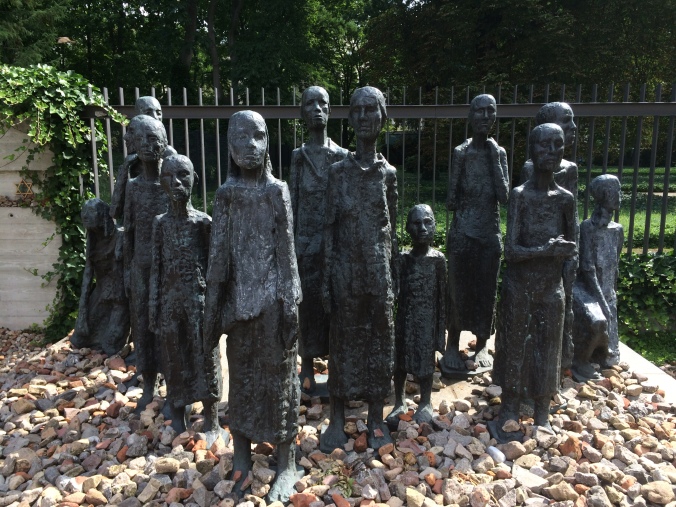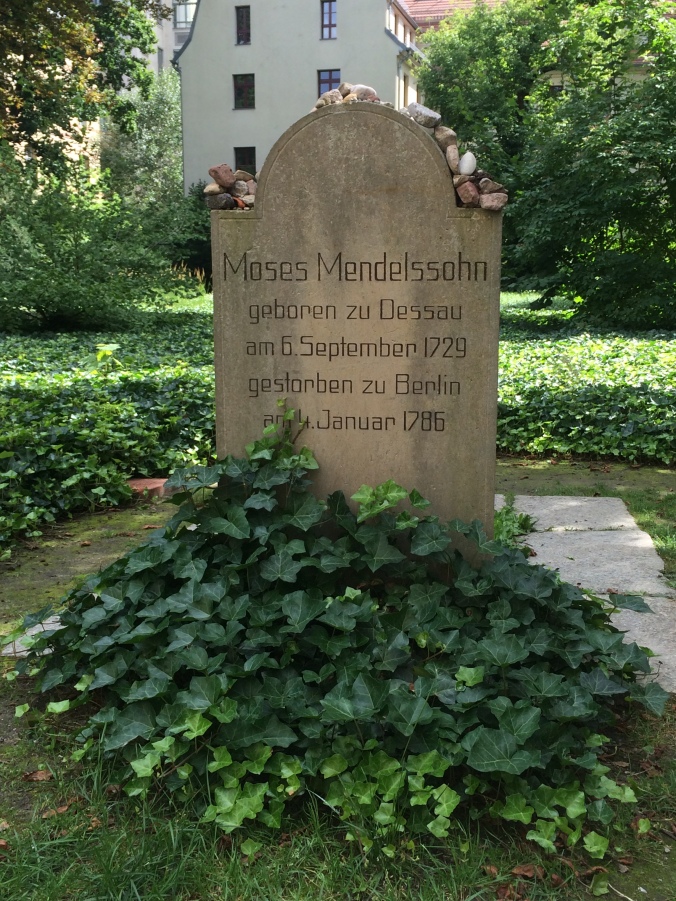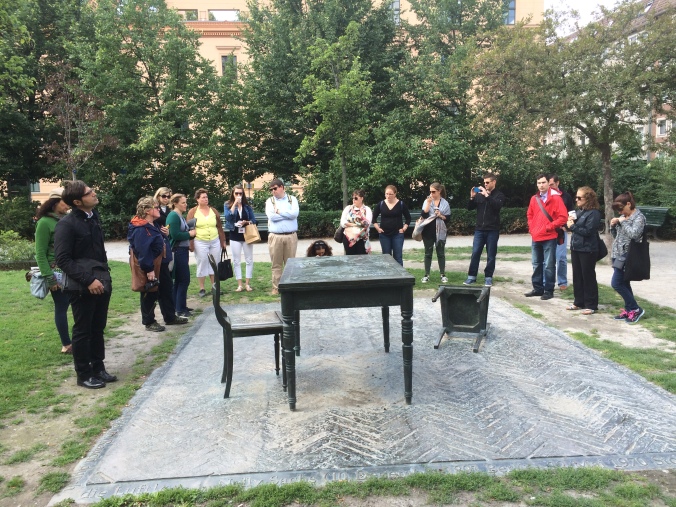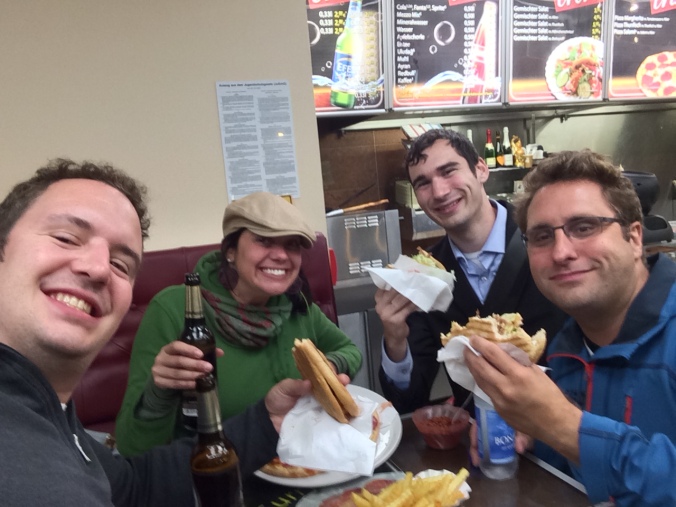Jewish Memorial Tour
Early Wednesday, we toured the older Jewish neighborhoods of East Berlin, and some of the nearby memorials commemorating their tragic history in the city during World War II and the Cold War.
Rykestrasse Synagogue
One major location we visited on our tour was the famous Rykestrasse Synagogue where we met with Rabbi and Holocaust survivor Andras Varga. This is one of the best preserved pre-war synagogues in Europe today. It was consecrated in 1904 and survived Nazi destruction largely due to its location. Where they normally demolished all synagogues during the time, they decided instead to burn its Torahs and destroy the furniture, as it was located in a residential area and they did not want a full fire to spread to other homes in the neighborhood. During the reign of the GDR, Rykestrasse stood as the only functioning synagogue in East Berlin. Prisoners of war were also allowed briefly to come here during the war to pray and hold services together. It is also the second largest synagogue in Europe today behind only the Great Synagogue in Budapest. As with other Jewish locations in the city of Berlin, we were only allowed in after our credentials were verified by armed guards standing at the entrance to the building.
Another site that we visited during our tour was a Jewish cemetery that had been closed in 1827. Near the end of World War II in Germany, as the Soviets began to invade Berlin, Nazis dug up the graves and used the tombstones to take defensive positions. As if this wasn’t horrifying enough, according to Jewish law, if a grave is disturbed, than the individual will not be resurrected when the Messiah comes, meaning all of the graves that were ruined during this fighting led to all of these souls never seeing the afterlife. Today, though they have replaced the tombstones, the remains of the bodies are scattered below the earth, impossible to fully return to their original condition.

Above: A monument outside the cemetery dedicated to child victims of the Holocaust- The rough translation is that this was the location where Jews went in Berlin before they were shipped off to the Concentration camps. 55,000 from kids to elderly were dragged off and murdered. Don’t forget the past, fight war and honor freedom.
One tombstone that was particularly interesting there was for Moses Mendelssohn, who was considered by many to be the father of Jewish enlightenment. He was originally buried here, so his tombstone was recreated to honor him and all the victims of the mass grave.

Another memorial that stood out to me during our tour was the Deserted Room by Artist Karl Biedermann. It was commissioned in 1988 to remember the 50th anniversary of the Night of Broken Glass, when German SA Stormtroopers destroyed Jewish homes, synagogues and businesses throughout Germany. Though it looks simple at its onset, the view of the abandoned room powers over the observer, as each piece of furniture is larger than it would traditionally be.

Around the outside of the memorial, a ring of words by the poet Nelly Sachs reads as follows:
Oh the houses of death / invitingly appointed / for the host who was once a guest / Oh your fingers, / laying the threshold / like a knife between life and death / Oh you chimneyss, / Oh you fingers, / and Israel’s body as smoke through the air!
Prior to World War II, we learned that there were approximately 150,000 Jews who called Berlin home. Many fled their homes, were sent to death camps, or went into hiding in an attempt to survive the Nazis. By the end of World War II, there were only about 8,000 who remained.
Jews did return once the war ended, many to east, as they wanted to help rebuild and make things better again. There was also a large influx Jews from Poland who returned to Germany due to violent attacks they suffered when they attempted to return to their former homes. While they were away, people simply took over their homes, and were unwilling to give them back regardless of the circumstances.
West Germany gave back for the losses the Jews suffered during World War II, however East Germany did not want to repay, as they felt they were moving on with a new state which had no connection to their past.
This led many Jews who first went east to immigrate west because they weren’t receiving the same benefits West German Jews received. As a result, only 2,000 Jews were left in East Berlin when the Berlin Wall went up, and only 450 remained after its destruction.
Rosenstrasse Protest
Perhaps the most awe-inspiring monument that we saw on our tour had to be the Block Der Frauen (Block of Women), a tribute to the women who protested during WWII to get their husbands back safely from the Nazis. Roughly 8,000 Jewish residents of Berlin were rounded up at the end of 1943 as part of the final round of deportation and murder by the SS and the Gestapo forces. About 2,000 of these men were partners in mixed marriages who were previously spared due to these relationships. In horror at the prospect of what would happen to their husbands and fathers, about 600 women learned where they were being detained and began to protest. Over the course of a week, in the middle of Berlin, in the center of Nazi Germany, these women protested without any retaliation from the Nazi powers. Instead, the leadership abdicated and ended up returning the prisoners back to their wives and children over the next several days. These brave women directly saved their partners and were one of the only examples of people who managed to stand up against the Fuhrer and win.

Everywhere we traveled throughout the Jewish quarter, I felt sick. How could a people possibly be treated this way, like lesser animals, not once, but so many times throughout their history? The actions taken against the Jews and many of societies other “outcasts” by the Nazis was disgusting, shocking, and wrong. On the very streets we walked, less than a century ago, people were dragged from their homes en masse and sent on a ride to pain and death without justifiable reason. Though I am saddened by their horrific past, I applaud Berlin, and Germany as a whole, for acknowledging the atrocities here rather than trying to forget about them, as so many other are wont to do.
These former Jewish neighborhoods are filled with hundreds of monuments to remind us that the past happened, that it is not okay, and that it will never happen again. Germany’s courage to face their complicated past should serve as a model for the world to follow, because knowledge is our only true triumph over evil. As many people today struggle with accepting others who “do not belong” simply because they come from a different cultural or religious background, Germany proves to be the model for using their painful past as a weapon to help defeat intolerance and bigotry.
Group Reflection
At the end of the Jewish tour, we met at six for a reflective period in our hotel before having dinner together. Wood went through the schedule for our final days and then opened the floor for everyone to talk about their reflections from our experience thus far.

To me, the key takeaway from our conversations was how surprised everyone was at current German culture. We all came into this experience with certain expectations, but no one was prepared for the myriad of experiences we were able to go through. Modern Germany is a complex and ever-changing place, but they really cherish their history because they realize just how important it is for a successful future. Currently they have accomplished a number of great things that we were able to learn from and take with us for our classrooms and communities back home. However, this country still faces many questions and challenges in the future, especially due to their growing concerns with immigration from the Middle East. It will be interesting to see where their issues progress in the years to come, and hopefully we will continue to glean lessons from one another into our futures.
Dinner
Wednesday evening, we met with a representative of the Federal Republic of Germany, Oliver Owcza, for an informal dinner meeting. Mr. Owcza has been a career diplomat since 1993 and currently was Deputy Head of the Task Force for Humanitarian Aid in the Federal Foreign Office in Berlin. He was very charismatic and spoke fondly of the United States and the importance of a successful alliance between our two countries today. Recently, Mr. Owcza toured 5,500 miles of the United States with his family, and it was amazing to hear of his journeys and the various sights they took in along the way. It was also great talking to someone who was able to find positives in everything and learn more about the importance of our relationship as nations with one another.
Germany is the lifeblood of the European Union today, and the rest of Europe really looks to Germany for guidance in the recent immigration crises as well as the current threat of terrorism throughout the region, similar to the role the United States plays in the world as well. What stands out more however, is the reluctance Germany has to take such a mantle. As a country once hellbent on taking over the world, they now have very little interest ruling in the affairs of others, and really want to take more of a helpful and humble role in world politics rather than a commanding one. With leaders like Mr. Owcza, I am confident that Germany will find a way to help lead the rest of Europe out of the current immigration crisis.
Midnight Tour
Following dinner, we went on the famed midnight tour that Wood guides all of his TOP groups through. We walked the city from roughly 10-12:30, taking in the sights of many famous historical structures including the Holocaust Memorial, the Berlin Dome, Humbolt University, and the Brandenburg Gate.
This was genius because at night we were unencumbered by the typical mobs of tourists at each of the major locations. It was also fitting to see so many of the memorials at night, as all were equipped with beautiful lights to showcase their importance at any time of day.
Perhaps the most jarring was the Tiergarten Memorial to the Murdered Jews of Europe. The memorial can be entered from all sides and is quite large- encompassing 19,000 square meters. Though the concrete stones start very low to the ground on each side, as one walks through they grow and begin to tower above you. Walking through the monument at night was particularly disturbing, as I felt enveloped in the pain and suffering of the millions of victims.
The night ended on a happier note however when Wood, Trisha, Jake and I went to get a snack before heading back to the hotel. To say that the owner of the Bratwurst cafe was enamored with Trish would be putting it lightly. Somehow before we were done, he had turned on blaring techno music and convinced Trish to dance with him, making for a truly unforgettable end to our evening.

Slap-happy and over-tired, we headed back to our hotel for the night, knowing more was to come tomorrow. I couldn’t have ever predicted the amount of interesting experiences this trip would provide, the lessons I would be glean, or the friendships I would make on this journey. Though I tried pushing it from my mind, I came to the dreaded realization that our time in Germany was soon coming to an end, and I wasn’t ready for it yet. With only two days remaining, I needed to make the most of the time I had left. Unfortunately, tomorrow, I knew, was going to be the hardest day of the trip by far- we were heading to a concentration camp in Sachsenhausen, and no amount of research or understanding could have prepared me for the experience to come.












